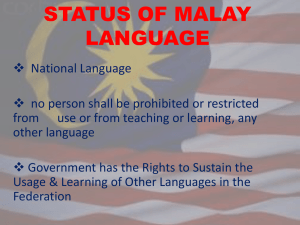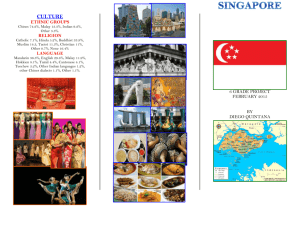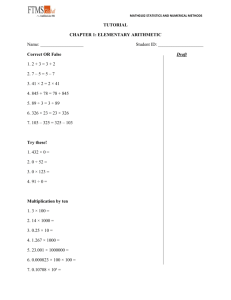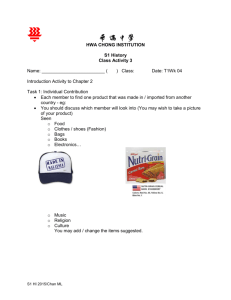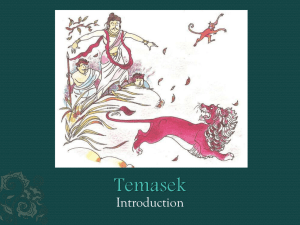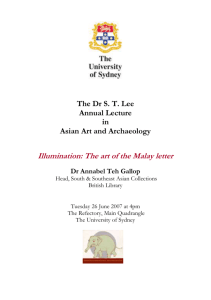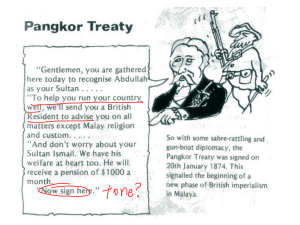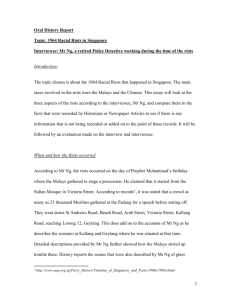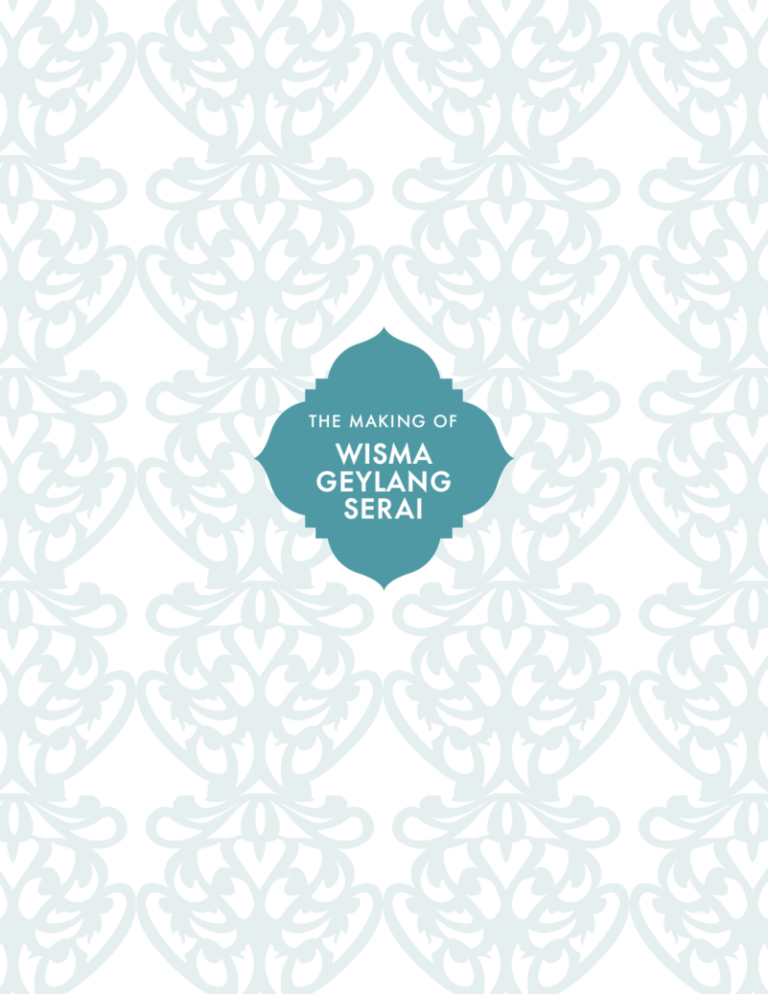
the making of
wisma
geylang
serai
The Making of Geylang Serai
is the story of Singapore’s
long-standing commitment
to preserve, develop and
promote this heritage area.
It recounts Geylang Serai’s
rich history and steady
progress over the years,
as well as articulates our
aspiration for it to have its
own place in the heart of
modern Singapore while
keeping to its historical and
cultural values.
a short message from
prime minister
prime minister
lee hsien loong
“As Singapore continues to develop, we also want
to celebrate our shared history, build a sense
of ownership and belonging, and maintain our
emotional links with family and friends. The Malay
Community have deep emotional ties to Geylang
Serai. Many older Malay Singaporeans lived and
played there in the old kampong days. As the
Malay proverb says: ‘Tempat jatuh lagi dikenang,
inikan pula tempat bermain’ (One remembers
fondly one’s childhood home). At the 2011
National Day Rally, I shared plans to develop a
new civic centre for Geylang Serai on the site of the
former Malay Village. This will house the Geylang
Serai Community Centre, amongst other facilities.
A heritage gallery will remind us of the old
Geylang Serai. To enhance Geylang’s Malay
feel and character even as the neighbourhood is
modernised and upgraded, there will be Malay
architectural touches, especially along Geylang
Road. Dr Maliki Osman is overseeing this project;
I hope our plans will help Geylang Serai retain its
special place in the heart of the community.”
The Making of Wisma Geylang Serai
from the chairman
Foreword
dr mohamad
maliki bin osman
senior parliamentary secretary
ministry of national development,
ministry of defence, and mayor
(southeast district)
I
t has been a fruitful and heartwarming journey since Prime Minister
Lee Hsien Loong announced the
development of a new Civic Centre at
Geylang Serai in August 2011. Since
then, I have met many people who
have generously offered their time to
this project. While they come from
different walks of life – the designers,
architects, art practitioners, grassroots
and community representatives, as
well as members of the public, they
have one thing in common: all of them
are passionate about creating a new
Civic Centre that is meaningful to all
of us. It has been truly encouraging
and I am very grateful for the
support given.
This book chronicles the story of the
Wisma Geylang Serai thus far. One
particular aspect that we paid special
attention to was the name of the civic
centre – we wanted the community
to have a part in deciding the name
for this significant project. Wisma
Geylang Serai was voted in by more
than 1000 people in an intense
Name It! competition that saw more
than 380 suggestions. It reflects the
distinctive cultural identity of Geylang
Serai, as well as its aspirations to be
forward-looking and cosmopolitan.
In this journey, we have dedicated
much time to seek feedback from all
quarters of the community. It is our
goal to capture the unique history
and the character of the people who
live and work in the neighbourhood.
Wisma Geylang Serai will reflect
the rich multi-cultural and racial
heritage of Geylang Serai. Influences
of the rich Malay heritage will be
incorporated in the Civic Centre
and along the streetscape of the
Geylang Serai precinct when it is
fully developed. We also want to
encourage Malay trades to remain in
the area and will give opportunities
for it to evolve over time into new
developments in Geylang Serai.
The character of the place is also in
its buzz, as much as in its architecture.
Wisma Geylang Serai will be
a meeting place for residents of
Geylang Serai. The Geylang Serai
Community Club, to be sited within
the Wisma Geylang Serai, will have
a variety of recreational activities
and programmes. The Southeast
Community Development Council
will also be sited in Wisma Geylang
Serai. Over at the new Civic Plaza,
we can look forward to an active
calendar of performances, exhibitions,
festive and market bazaars. The Civic
Plaza will be home to the annual
Hari Raya Light-up and Festive
Bazaar which has become an icon of
Geylang Serai over the years. Wisma
Geylang Serai will anchor Geylang
Serai as one of the vibrant places
in Singapore for arts, heritage and
culture. All these will be happening at
the same time as Paya Lebar Central
shapes up to be a regional hub for
office and residential developments
with a range of lifestyle options.
Wisma Geylang Serai is an exciting
project for the Malay community,
residents of Geylang Serai and all
Singaporeans. A strong collaboration
between the people sector and
government agencies has brought
about much progress so far. To
drive and sustain Wisma Geylang
Serai in the long term, we must
continue to communicate and work
with one another. I look forward to
your continued support as we work
towards the successful completion of
this iconic project for Geylang Serai
and for Singapore.
The Making of Wisma Geylang Serai
VIII
Contents
Setting the Context
01
Our Shared Vision
11
Working Together
15
Public Feedback
23
Realising the Vision
35
setting the
context
01
Setting the Context
The Making of Wisma Geylang Serai
History of
Geylang Serai
learning street names in geylang from the past
Eunos Ave, Eunos Road, Jalan Alsagoff, Engku Aman Road and Aljunied Road. These are some of the streets in
Geylang Serai that have been named after prominent people, in recognition of their contributions and public service
to the community.
A
t the heart of Singapore’s urban
landscape lies several unique
neighbourhoods that are inextricably
linked to the history, heritage and
culture of Singapore. One such
distinctive area is Geylang Serai.
Geylang Serai is one of the oldest
Malay settlements in Singapore.
Today, it is also well-known in the
region as ‘The Malay Emporium
of Singapore’. It is a haven for
shopping, with shops of every
conceivable size, selling all types
of wares from traditional handicraft,
household items to jewellery.
One can still detect the aroma of
traditional cuisine along the streets.
what does geylang
serai mean?
While it is clear that Serai
originated from the aromatic
lemongrass or citronella which
was cultivated in the area, the
origin of ‘Geylang’ is less clear.
There are interesting theories that
this could have been derived
from various Malay references,
such as ‘kilang’ (which means
‘factory’), ‘gelang’ (which
means ‘bracelet’ or ‘anklet’),
or ‘gelenggang’ (which means
‘arena’). Others have suggested
that this could have been
named after a herb that once
grew abundantly on nearby
sandy shores called Gelang
pasir (Portulaca oleracea), or a
tribe of seafaring warriors who
roamed Singapore’s coast called
Orang Gallang.
1800s
Its Origins
T
he history of Geylang Serai began
in the 1840s. This area had been
mostly uninhabited until the British
colonial government relocated the
Orang Laut (sea nomads) and Malay
villagers from the Singapore River to
the Geylang River area in 1842-43.
This new district became known as
Geylang Kelapa (kelapa is ‘coconut’
in Malay) because of the coconut
plantations in the area. It is believed
that the area became known as
Geylang Serai in the 1890s when
the coconut plantations gave way
1910
Eastern terminal for tramline
02
to lemongrass (known as serai in
Malay) cultivation by three wealthy
Arab families – the Aljunieds, the
Alkaffs and the Alsagoffs. The largescale lemongrass plantations and
factory were prominent features in the
1890s. Malay and Chinese farmers
turned to the cultivation of coconuts,
rubber, vegetables and the rearing of
poultry when demand for lemongrass
fell at the end of the 1800s. The
former lemongrass factory site was
converted into an eastern terminal for
Singapore’s first tramline in 1910.
ALSAGOFF
engku aman
EUNOS
jalan alsagoff
engku aman road
eunos ave and eunos road
Parts of the present Eunos Road
and Geylang Serai Road were
formerly named Jalan Alsagoff. In
1848, Syed Abdul Rahman Alsagoff
arrived in Singapore with his son
and set up Alsagoff & Company. The
Alsagoffs were prominent traders
and philanthropists and donated
generously to endowments for
Islamic schools and charities.
Engku Aman Road (which runs
parallel to Geylang Serai Road)
is named after Abdul Rahman bin
Taha Alsagoff (1880–1955), a
philanthropist and landowner.
The title ‘Engku’ reflects his Bugis
royal descent.
Eunos Ave/Road (Jalan Eunos)
is named after prominent Malay
pioneer and ‘Father of Malay
Journalism’, Mohammed Eunos
bin Abdullah. He helped to set up
the Malay newspaper, Utusan
Melayu in 1912 and contributed
to the Malay community and
public service as the Municipal
Commissioner. He was also the first
Malay in the Legislative Council and
a founding member of the Kesatuan
Melayu Singapura (Singapore’s first
Malay political body).
1800s
An old map of Singapore, showing the boundaries of Geylang.
The blue circle indicates where modern Geylang Serai is today.
03
Setting the Context
The Making of Wisma Geylang Serai
1900s
C
Chairman of the Singapore Malay
Union, established Kampung Melayu
(Malay Village) to provide affordable
housing for Malays.
During the Japanese Occupation
of Singapore (1942-1945), tapioca
(ubi kayu in Malay) was made the
staple food. Tapioca farms replaced
coconut and rubber plantations
and the area became known as
Kampung Ubi (‘Tapioca Village’ in
Malay). Today, Ubi Road serves as
a reminder of that period.
inemas were a major attraction
for Geylang Serai residents in
the early days. The cinemas would
be packed with people, especially
on weekends. Cinema-goers could
choose from outdoor cinemas, such
as the ’10 cents open air cinema’, to
indoor ones, such as the Taj Cinema
(later renamed Singapura Theatre),
Garricks Cinema (later renamed
Galaxy Cinema) and Queen’s
Cinema. Patrons would pay 10 to
20 cents each to camp out on lawn
chairs under the stars, compared with
After the war, new Malay and
Chinese settlements were established
in Geylang Serai. By 1957, an
estimated 360,000 people lived in
Geylang Serai. The new residents
erected wooden huts with attap roofs.
Jalan Al Sega
s Singapore’s trade continued to
flourish, it attracted Malay traders
from the Malay Peninsula and nearby
Indonesian islands. Javanese and
Boyanese immigrants came to work
in the pepper, gambier and rubber
plantations that were opened up. The
residential population in Geylang
Serai grew steadily. In 1929,
Encik Muhammad Eunos Abdullah,
05
entertainment
The Early Settlement
A
04
50 cents to one dollar to watch a
movie indoors. The cinemas screened
movies of different languages,
including English, Chinese, Malay,
Hindi and Tamil. There were also
other theme parks such as Gay World
and Eastern World Amusement Park.
10¢
cinema
‹ Paya Lebar MRT
Eunos MRT ›
His kampong
Jalan Geylang Serai
“I remembered watching
Malay horror movies about
traditional legends, like
Malay Village
the Pontianak, Jerangkung
Geylang Road
and Orang Minyak, at the
Queen’s Cinema with my
Garricks
Cinema
pals. On our way home
after these movies, we would
sometimes choose the route
that would lead us past a
cemetery – we did this just to
give ourselves a big scare.” “I enjoyed going to
Mr Dick Yip, resident of Geylang Serai
Gay World with my
friends. It provided all
sorts of entertainment
– from cabaret, opera,
movies and games – at
affordable prices for locals.
That
was in the past, before
Collection of R Browne
Courtesy of National Archives of Singapore
television and cinemas were
Happy World, set up in 1936,
more common.”
1950s
Government standpipes
provided villagers with water
in the early kampong days.
“When I was 13 years old, there wasn’t water supply to
every house. I had to walk to a government public standpipe
a few times a day to fetch water. Everyone in the kampong
also shared a common toilet. It was a wooden structure with
a zinc roof.”
Mr Shaik Kadir, 67, resident of Geylang Serai since 8 years old
was renamed Gay World in
1966 and closed down in 2000.
Mr Alagmir, baju seller at Geylang
Serai Market
Eastern World
Amusement Park
Bus terminal
Taj
Cinema
Changi Road
Market
(now Joo Chiat Complex)
Map provided by Mr Shaik Kadir
“From the 1960s to 1980s,
the Taj Cinema was the
main entertainment centre
for teenagers and adults
living in Geylang Serai. It
screened Malay, Western,
Bollywood and Arab movies.
The first Malay movie
screened at the cinema was
titled Toping Saita.”
Madam Jamilah, baju melayu seller at
Geylang Serai Market
Setting the Context
1960s – 1980s
The Making of Wisma Geylang Serai
06
geylang serai market
Building a Modern Geylang Serai
T
he efforts to transform Geylang
Serai into a modern housing estate
started in the 1960s, in line with the
nation-wide move to provide public
housing across Singapore.
Under Phase One, starting from
1963, the Housing and Development
Board (HDB) unveiled a $3.7 million
Geylang Serai Redevelopment
Scheme to develop the area into a
modern housing estate with shopping
and recreational facilities and
amenities. It was the first government
housing project in the east of
Singapore. In 1965, about 4,000
residents moved into new flats in
Geylang Serai.
In 1973, the Government announced
Phase Two of plans to further develop
Geylang Serai into a modern satellite
complex, with low-cost housing and
light industries.
By the time Phase Three began in
the 1980s, the old kampongs were
gone. Geylang Serai continued to
grow as a vibrant centre of culture
and commerce. The region earned its
reputation as ‘The Malay Emporium
of Singapore’, drawing Malays,
overseas visitors and Singaporeans
of all races to the area.
(From top)
Phase One and Two
of Geylang Serai
Redevelopment Scheme
Collection of Quek Tiong Swee
Courtesy of National Archives of Singapore
The iconic Geylang Serai Market was
opened by then Prime Minister Lee
Kuan Yew in 1964. Located between
Changi Road and Sims Avenue, the
Geylang Serai Market was the only
halal wet market and hawker centre
in Singapore. With more than 400
stalls, the Geylang Serai Market was
a draw for Malay families from all
over Singapore and shoppers from
Malaysia in the late 1970s and
early 1980s.
The current Geylang Serai Market
was redeveloped in 2003 as part
of the government’s upgrading of
older estates under HDB’s Selective
En Block Redevelopment Scheme
(SERS). The market building design,
which drew inspiration from traditional
Malay architecture, features high,
sloping roofs and timber panels,
rich fabric and weaving patterns
and verandas. It has since become
an iconic landmark in the area. The
market is an important focal point
for many social and economic
activities of the Malay community
at large. One of its highlights is the
annual Hari Raya Bazaar, which is
held on the spacious grounds in front
of the market.
1964
Geylang Serai Market drew large crowds daily.
“When I first set up my business in Geylang Serai, there
weren’t any roofs or walls. People would lay their
goods out on the cement floor to sell. Gradually people
started to build their own stalls with walls and roofs
made of planks or bricks.”
Madam Esah Binte Hashim, shop owner at Geylang Serai market for more
than 20 years selling baju kurungs
“I remember the adorable baby chicks and live chickens.
Unlike markets today, they would only be killed when
they were sold.”
Mr James Koh, grassroots member for 22 years
07
Setting the Context
The Making of Wisma Geylang Serai
the malay village
08
hari raya light up
Decorative arches over
Geylang Serai Road
The first Hari Raya Light Up in
Geylang Serai took place in
1984, when the community
erected arches over Geylang
Serai Road and dressed up street
lamps with decorative ketupats
(rice cakes) and bunga manggar
(bridal flowers). Every year
since then, during the month of
Ramadan, the streets around
Geylang Serai would come alive
with colourful lights and festive
décor. The festive mood was
Source: Ministry of Information,
Communications and the Arts
Courtesy of National Archives of Singapore
1989
The Malay Village was completed and opened.
In 1989, the Malay Village was built across the road from
the Geylang Serai Market. The village would promote
Malay culture and preserve their heritage through the
showcase of Malay arts, handicrafts and other cultural
activities, and also provide a market place for a large
variety of Malay goods and souvenirs. These range from
decorative items like handicrafts, paintings and artefacts,
to rugs and fabrics, modern wear clothes, trinkets, wooden
crafted materials and much more.
Source: Ministry of Information,
Communications and the Arts
Courtesy of National Archives of Singapore
“My family members and relatives from overseas would
gather together at Geylang Serai to shop. This would
be a form of celebration during Ramadan. Those were
also one of the happiest moments he experienced. My
dad would always bring me to the chendol shop down
the street.”
Mr Rosman, owner of Muzuka Record who used to live in
Kampong Kembangan in a traditional house
enhanced by a giant street bazaar
of hundreds of stalls offering Malay
delicacies and a wide gamut of
items, from clothing, jewellery to
souvenirs and home furnishings.
(From left) Giant street bazaar
selling all sorts of wares and
items; Handicraft stalls at the
bazaar selling handmade items
Besides being a shopping paradise, the Malay Village
became home to the Kampung Museum, Art Gallery
and Hall of Fame, which featured a large collection of
traditional Malay costumes, musical instruments and
tools. This potpourri of exciting activities engaged the
imagination of and encouraged participation amongst
the local community and visitors alike.
The Malay Village also
showcased Malay arts
and handicrafts.
Source: Ministry of Information,
Communications and the Arts
Courtesy of National Archives of Singapore
Courtesy of National Archives of Singapore
Source: Ministry of Information,
Communications and the Arts
Courtesy of National Archives of Singapore
09
Setting the Context
2000s
Shaping Geylang Serai
for the 21st Century
O
ver the last decade, Geylang
Serai has undergone
rejuvenation projects to further
improve the living standards and
make it more vibrant for residents
and visitors. In the coming years,
the Geylang Serai precinct will
undergo further redevelopment
as part of the larger Paya Lebar
Central district. It is set to become
a commercial hub with offices,
hotels, retail and attractive public
spaces. This redevelopment is part
of URA’s Concept Plan to provide
alternative locations for businesses
and provide jobs closer to homes.
Located just a ten-minute drive from
the city centre, Paya Lebar Central is
well connected by major expressways
like the Pan-Island Expressway (PIE)
and the East Coast Parkway (ECP), as
well as major roads like Sims Avenue,
Paya Lebar Road and Changi Road.
Accessibility is further enhanced with
the Paya Lebar MRT station, which
is an interchange for the Circle and
East-West lines.
In 2011, the government announced
that the new Geylang Serai Civic
Centre would be built on the site of
the former Malay Village. Recognised
to have a special place in the heart
of the Malay Community, Geylang
Serai’s unique identity will be
retained even as it moves into the
next phase of development of
Wisma Geylang Serai and the
larger Paya Lebar Central.
Artist’s impression of Wisma Geylang
Serai along Geylang Road.
our shared
vision
O
ver the last 14 months, a cross-section of the community within and
outside of the Geylang Serai precinct, together with representatives
from different government agencies, came together to co-create a shared
vision for the new Civic Centre. This shared vision also incorporated valuable
inputs from members of the public, who had spent precious time to share their
views through the consultation sessions, focus group discussions and the
Wisma Geylang Serai Facebook page. This shared vision centres around three
key themes.
Our Shared Vision
The Making of Wisma Geylang Serai
1
A culturally distinctive
Civic Centre that
celebrates the heritage
of Geylang Serai
We want to create a Civic Centre that celebrates the heritage
of Geylang Serai and is a window into the rich Malay arts and
culture. The name for the Civic Centre, Wisma Geylang Serai,
reflects the Malay heritage and essence of the Civic Centre,
and at the same time, is forward-looking and cosmopolitan. The
name also conveys our aspirations for the Civic Centre and its
connections to the larger Geylang Serai. To further enhance the
influences of the Malay architecture on the new Civic Centre, we
kept a number of decorative ornaments from the former Malay
Village. We hope the design team would be able to re-interpret
these ornaments meaningfully and incorporate them into the
design of the new Civic Centre in future.
Wisma Geylang Serai will also feature spaces and uses that
could distinguish it from a typical civic centre. The Malay
Heritage Gallery within the Civic Centre will be a place where
people can learn more about Malay culture and heritage,
in particular its presence within the Geylang Serai precinct
since the 1800s. We will encourage Malay traditional arts
and performing groups, and other cultural groups to establish
themselves at Wisma Geylang Serai. We are hopeful that the
collaboration and exchanges of ideas will provide a nourishing
ground so that the arts and culture of the Malays and other
ethnic groups would have opportunities to flourish.
2
An inclusive Civic
Centre that serves
all Singaporeans
We envision that Wisma Geylang Serai will extend beyond its
immediate boundaries and be connected to the larger precinct.
To achieve that, we will focus on making the Civic Centre easily
accessible. A pedestrian link, connecting adjacent facilities such
as the Geylang Serai Market, Joo Chiat Complex and the Paya
Lebar MRT Station, would transform Wisma Geylang Serai into
a key hub of Paya Lebar Central. It will be a natural gathering
place for all who live, work in and around the precinct.
The enhanced connectivity to the rest of the precinct brings the
wide range of facilities and services in Wisma Geylang Serai
to the community. The range of services under the Southeast
Community Development Council, like the Family Service Centre,
Childcare Centre and Integrated Day Facility, would be easily
reached. The Geylang Serai Community Club, which would be
relocated to Wisma Geylang Serai, would feature state-of-art
facilities for community events.
12
13
Our Shared Vision
3
The Making of Wisma Geylang Serai
A vibrant Civic
Centre that is
driven by strong
partnerships and
collaborations
Wisma Geylang Serai has many diverse elements that will
enhance the vibrancy and buzz of the larger precinct all year
round. The new Community Plaza within the development will
be home to the annual Hari Raya Bazaar, accompanied by
the light-up of Geylang Road throughout the festive month. The
pedestrian mall will be lined with smaller shops and eateries,
and could feature exhibitions and performances from arts and
cultural groups. The streets along Geylang Road will be much
livelier all year round.
Redevelopment and rejuvenation of a shared space goes
beyond constructing a new building. For Wisma Geylang Serai
to be meaningful and sustainable, it needs to engender a deep
sense of ownership within the community. We look forward to
continued strong collaboration between the people, public and
private sector in this project. The conversation and exchange of
ideas would continue from here.
working
together
14
15
Working Together
The Making of Wisma Geylang Serai
16
17
civic centre
public consultation
main workgroup
connectivity & urban design
programming
MARCH
FEB
we need a
name for the
civic centre
Working Together
The Making of Wisma Geylang Serai
Composition of
Wisma Geylang
Serai Workgroup
Workgroup
Discussions
T
“The annual Hari Raya Bazaar will remain as a regular
feature for Geylang Serai. The planned 10m-wide
pedestrian mall along Geylang Road would provide space
to accommodate the bazaar stalls in future.”
he main workgroup compromises people from across different sectors, public
agencies and professional practitioners of arts and culture.
1. Dr Mohamad Maliki Bin Osman
Senior Parliamentary Secretary
Ministry of National Development
Ministry of Defense
Mayor (Southeast District)
2. Zuraidah Abdullah (Mdm)
Chairperson
Malay Heritage Foundation
3. Amri Amin
Music Director and
Principle Conductor
Orkestra Melayu Singapura
4. Chua Ai Liang (Ms)
Director
Arts and Communities
National Arts Council
5. Stanley Fong
General Manager
Southeast Community
Development Council
People’s Association
6. Foo Soon Leng (Ms)
Director
People’s Association
7. Foong Hin Cheong
Deputy Director
Southeast Community
Development Council
People’s Association
8. Osman Abdul Hamid
Artistic Director
Era Dance Theatre
Boardmember
Malay Heritage Foundation
9. Moliah Hashim (Ms)
CEO
Mendaki
10. Hwang Yu-Ning (Ms)
Group Director (Physical Planning)
Urban Redevelopment Authority
11. Julina Khusaini (Ms)
General Manager
Malay Heritage Foundation
12. James Koh Chee Kiat
Chairman
Geylang Serai Community Club
Management Committee
13. A/P Fatimah Lateef
Member of Parliament
Marine Parade GRC
14. Lee Hwee Wan (Ms)
Assistant Director (Design & Planning)
People’s Association
19. Norsaleen Salleh (Ms)
Assistant Director
(Heritage Institutions)
National Heritage Board
20. Abdul Rohim Sarip
President
Singapore Malay Chamber of
Commerce and Industry
21. Sahid Sukintal
Chairman
Geylang Serai Malay Activities
Executive Committee
22. Dr Suriani Suratman (Ms)
Deputy Chairman
Malay Heritage Foundation
23. Dr Imran Tajudeen
Assistant Professor
School of Architecture and Design
National University of Singapore
15. Eugene Leong
Senior Director (Strategic Planning)
Ministry of National Development
24. Eric Wong Ngaim Chin
Chairman
Geylang Serai Citizen
Consultative Committee
16. Zizi Azah Majid (Ms)
Artistic Director
Theater Ekamatra
25. Yatiman Yusof
Former Member of Parliament
17. Neo Ailing (Ms)
Project Manager (Design & Planning)
People’s Association
26. Zulkiflee Mohd Zaki
Director (Physical Planning,
Central East)
Urban Redevelopment Authority
18. Zahidi Abdul Rahman
Principal Architect
Zahidi A.R. Arkitek
“The Malay identity would be maintained and enhanced
through physical links to the surrounding Geylang Serai
area, as well as through the content of the new spaces
within the Civic Centre.“
18
19
“Beyond the planning
process and even after
Wisma Geylang Serai is
completed, there should be
a channel of communication
to allow continual feedback.”
Madam Moliah Hashim
Dr Maliki Osman
“The long-term sustainability of Wisma Geylang Serai would
happen if integrated with the larger precinct. We should allow
activities that could be beneficial in improving the vibrancy of
the area which could be staged beyond the Civic Centre.”
“There should be public voting in selecting the name of
the Civic Centre so that we can involve the community
in the process.“
“The diversity of forms
and functions within the
building should contribute
to the Civic Centre having
a distinctive identity.“
Dr Suraini Suratman
Mr Yatiman Yusof
“WGS is intended to be outward looking and inclusive in
that it connects and engages people from various
communities and across all ages.
A diversity of services and programmes will provide
opportunities for collaboration and exchanges of ideas.
However, it was important to ensure that the services and
programmes were appropriately placed within the building.”
Mr Khairudin Saharom
“A mix of services and
programmes would allow for
more optimal use of space
and will help improve the
vibrancy in the building over
different times of the day.”
Mr Zahidi Abdul Rahman
Working Together
The Making of Wisma Geylang Serai
Civic Centre
Sub-Group
Connectivity
and Urban
Design Sub-Group
assoc prof fatimah lateef
ms hwang yu-ning
chairperson — civic centre sub-group
member of parliament for marine parade grc &
advisor to marine parade grc grassroots organisations
chairperson — connectivity & urban design sub-group
group director (physical planning)
urban redevelopment authority (ura)
O
ver the last year, we have held
many sessions of fruitful
planning and discussions to shape
the vision for the Wisma Geylang
Serai (WGS) project.
The WGS will be an icon and a focal
point in the Geylang cultural hub,
embedded in the Paya Lebar-Geylang
sub-regional centre. With the rapid
changes and redevelopment in the
area, including the ABC (Active,
Beautiful and Clean) water project
on the Geylang River as well as the
various commercial and civic parcel
projects coming up, Geylang Serai
will become a very exciting and
vibrant area.
I would like to thank all the workgroup
members, grassroots leaders,
residents, students and members
of the public who have come
forward to contribute their ideas and
suggestions. Their inputs gathered on
all fronts – focus group discussions,
dialogues, face-to-face interactions,
emails, Facebook – have been most
valuable. Many of them continue to
be active in our discussions today, and
I would encourage them to keep this
community spirit alive.
In particular, I look forward to our
new Geylang Serai Community Club
in WGS. We are now planning the
range of new-generation performance
1. Dr Mohamad Maliki Bin Osman
Senior Parliamentary Secretary
Ministry of National Development
Ministry of Defence
Mayor (Southeast District)
4. Osman Abdul Hamid
Artistic Director
Era Dance Theatre
Boardmember
Malay Heritage Foundation
2. Stanley Fong
General Manager
Southeast Community
Development Council
People’s Association
5. James Koh Chee Kiat
Chairman
Geylang Serai Community Club
Management Committee
3. Foong Hin Cheong
Deputy Director
Southeast Community
Development Council
People’s Association
facilities and the types of programmes
and activities that the Community
Club will feature. With the mix of
facilities coming up in the WGS,
there will be more opportunities for
collaboration and partnership with
residents and members of the public.
It is my hope that Wisma Geylang
Serai will become a one-stop venue
for community activities, arts and
cultural events and a meeting point for
locals and visitors to Singapore.
6. Lee Hwee Wan (Ms)
Assistant Director (Design & Planning)
People’s Association
7. Neo Ailing (Ms)
Project Manager (Design & Planning)
People’s Association
W
isma Geylang Serai (WGS)
will be an exciting addition
to the physical, cultural and social
landscape of Geylang Serai.
The Connectivity & Urban Design
sub-group has been mindful that
the urban design for WGS needs
to reflect the context of the site and
integrate with the future plans for the
larger Geylang Serai Precinct. In the
urban design guidelines, this is also
balanced with the intention to provide
1. Natapon Akomsoontorn
Architect (Urban Design 1)
Urban Redevelopment Authority
8. Zahidi Abdul Rahman
Principal Architect
Zahidi A. R. Arkitek
9. Abdul Rohim Sarip
President
Singapore Malay Chamber of
Commerce and Industry
10. Eric Wong Ngiam Chin
Chairman
Geylang Serai Citizen
Consultative Committee
11. Yatiman Yusof
Former Member of Parliament
12. Zulkiflee Mohd Zaki
Director (Physical Planning,
Central East)
Urban Redevelopment Authority
room for the architects to come up
with bold and creative designs for
the WGS. We have given special
attention to the accessibility and
connectivity aspects of the WGS
as well to cater to different groups
of users.
20
discussions. We are hopeful that
the urban design guidelines will
facilitate the eventual developer in
building a distinctive development
that will become a landmark and
an endearing community space for
Geylang Serai.
I would like to thank the members
of this sub-group for their active
participation. We have a good mix of
perspectives and the lively exchange
of views have helped to enrich our
6. Lee Hong Ping
Treasurer
Geylang Serai Citizen
Consultative Committee
2. David Chan
Secretary
Geylang Serai Community Club
Management Committee
7. Lee Hwee Wan (Ms)
Assistant Director (Design & Planning)
People’s Association
3. Eliza Choo (Ms)
Director (Urban Design 1)
Urban Redevelopment Authority
8. Look Boon Gee
Managing Director
LOOK Architects Private Limited
4. Gillian How (Ms)
Executive Planner (Physical Planning)
Urban Redevelopment Authority
9. Neo Ailing (Ms)
Project Manager (Design & Planning)
People’s Association
5. Isa Kamari
Manager (Commuter
Facilities Section)
Land Transport Authority
10. Khairudin Saharom
Principal Architect
KITE Studio Architecture
11. Aamer Taher
Principal Architect
Aamer Architects
12. Dr Imran Tajudeen
Assistant Professor
School of Architecture and Design
National University of Singapore
13. Zulkiflee Mohd Zaki
Director (Physical Planning,
Central East)
Urban Redevelopment Authority
14. Mohammed Asaduz Zaman
Vice President (Architecture)
Surbana International
Consultants Pte Ltd
21
Working Together
Programming
Sub-Group
dr suriani suratman
chairperson — programming sub-group
senior lecturer, department of malay studies, nus
deputy chairman, malay heritage foundation
I
t has been very exciting for me to be
part of the Programming Sub-group
to create a vision of what we would
like to see at WGS as an art and
cultural hub.
of the Programming Sub-group
contributed different perspectives and
had facilitated lively discussions on
how WGS can interweave social and
physical aspects of the space.
The sub-group benefited greatly
from the diverse experiences of
our members – art practitioners,
educators, cultural activists, as well
as representatives from People’s
Association, National Heritage Board
and National Arts Council. Members
The sub-group has also considered
the numerous ideas and suggestions
from members of the public. A series
of focus group discussions allowed
the sub-group to engage with different
stakeholders of the community. Their
contributions had been very valuable
1. Amri Amin
Music Director and
Principle Conductor
Okestra Melayu Singapura
7. Osman Abdul Hamid
Artistic Director
Era Dance Theatre
Boardmember
Malay Heritage Foundation
2. Shabirin Ariffin
Senior Manager
Segment Marketing &
Communications
SingTel
3. Belinda Choi (Ms)
Deputy Director (Arts & Culture)
People’s Association
4. Chua Ai Liang (Ms)
Director (Arts and Community)
National Arts Council
5. Oniatta Effendi (Ms)
Lecturer (Drama)
Lasalle College of the Arts
6. Art Fadzil
Head (Business Development Unit)
PERKAMUS
8. Isa Kamari
Architect
9. Julina Khusaini (Ms)
General Manager
Malay Heritage Foundation
10. Zizi Azah Majid (Ms)
Artistic Director
Teater Ekamatra
11. Ahmad Mashadi
Head
National University of
Singapore Museum
12. Haramain Osman
Songwriter and Music Producer
in helping us to consider how to
combine Malay culture and heritage
to make WGS a vibrant place.
I hope that potential users of the
upcoming WGS will in the long run
assume a direct interest in the space
and thereby be involved in making
WGS alive and vibrant.
13. Quek Yeng Yeng (Ms)
Deputy Director (Arts and Community)
National Arts Council
14. Rahman Rais
President
Association of Artists of
Various Resources
15. Norsaleen Salleh (Ms)
Assistant Director
(Heritage Institutions)
National Heritage Board
16. Seah Liang Bing
Vice-Chairman
Geylang Serai Community Club
17. Sahid Sukintal
Chairman
Geylang Serai Malay Activities
Executive Committee
18. Riz Sunawan
Producer-Presenter
MediaCorp News
public
feedback
Public Feedback
The Making of Wisma Geylang Serai
Focus Group
Discussions
24
civic centre as a…
Place for learning and for
intellectual discussions
Facilitate the transfer of relevant
knowledge and skills related to
Malay arts and culture
Resource centre to develop
intellectual aspect of Malay culture
Meeting point for
Malay Arts and
Culture practitioners
Comfortable precinct, bustling place that is
endearing & provides a sense of belonging
attributes
Outward-looking and inclusive place that connects
and engages all communities and all ages
T
he Programming Sub-group led
by Dr Suriani Suratman organised
a series of focus group discussions
where inclusiveness was a recurring
theme. Educators, independent arts
practitioners, representatives of arts
and culture clubs and associations,
as well as tertiary students gave
feedback on ways to make Wisma
Geylang Serai more vibrant and
relevant to the community. To them,
it is vital that Wisma Geylang Serai
evolves into an inclusive place: a
place for the young and old, for art
forms that appeal to the connoisseur
and the layman.
There was a wide range of
suggestions and feedback gathered
from these sessions that helped to
refine the objectives for programming
and the functions of the space
at Wisma Geylang Serai. It is
envisioned that Wisma Geylang
Serai would help to inculcate an
appreciation of Malay arts and
culture. Visitors would also have
opportunities to enjoy and participate
in the arts and cultural activities while
practitioners can come together with
emerging and established artists or
arts groups to interact, collaborate
and inspire one another. It is believed
that Wisma Geylang Serai can
become a vibrant multi-cultural space
that enhances the visitor experience
through its showcase of quality arts
and cultural practices.
Connect and engage a wide
spectrum of the community at large
Place that provides a window
into the Malay arts and culture
how to evoke the malay character/identity
Architecture is
not sufficient
Artistic elements through murals, mosaics,
artworks and motifs
Include old road names and iconic landmarks in
the naming of the floor levels
Offer experience of ‘kampung’
without decorations or ornamentations
Name of
Civic Centre
Place that offers diverse
programmes beyond just
arts and culture
Invoke spirit of the
Malay community
25
Public Feedback
The Making of Wisma Geylang Serai
NUS Architecture
Workshop
types of programming
Family-oriented
activities
Need to include lifestyle elements
such as sports and music
Collaborative works that reflect
community engagement
Balance between traditional
and contemporary art
I
n our efforts to build on an inclusive
society, we embrace different views
to build a home that we all love
and cherish. It was with the idea
of finding out how different people
perceived Wisma Geylang Serai that
the Connectivity and Urban Design
Sub-group organised a workshop with
Year Three NUS Architecture students
to brainstorm ideas for a draft master
plan for Wisma Geylang Serai.
A residency programme of
6 months for practitioners
Workshops and classes
by arts practitioners
sustainability
Diversity of activities beyond performing arts/exhibitions to
include intellectual and discursive type of activities
Extent of outreach beyond Geylang Serai
to rest of Singapore and visitors
Physical accessibility to
the Civic Centre
Affordable rates for use
of space
‘Reinventing’ of traditional forms to
make it relevant to current context
Need to develop an ecosystem that supports the arts/
culture activities at the civic centre
Balance of centralised programme
versus self-organised activities
Clarity in programming
goals and content
Dr Imran Tajudeen, Assistant Professor
at NUS School of Architecture
and Design and member of the
workgroup, helped to conduct a
briefing to the students to provide a
more complete understanding of the
history of the Geylang Serai precinct,
and the context within which the
development of Wisma Geylang
Serai is proceeding.
The students came up with many
unique ideas. For instance, one of the
suggestions was to connect all the
key landmarks in the Geylang Serai
Precinct – such as the Tanjong Katong
Complex and Paya Lebar MRT station
to Wisma Geylang Serai via an
underground network. Another idea
was to create small spaces around
the civic centre which could be used
for community purposes. One group
proposed to do away with the idea
of Wisma Geylang Serai as a single
building but instead, develop it as
an open space with multiple smaller
buildings. The students will continue
to work on their ideas and develop
a concept for a community hall in
Wisma Geylang Serai. We also
hope that these ideas will inspire
professional architects who would be
designing it in future.
“Our students were acquainted with planning and urban
design issues for a specific socio-cultural context. They were
challenged to develop creative interpretations of the Civic
Centre for the Geylang Serai Community, and hope the
Civic Centre will evolve into a beloved landmark.”
Mr John Fung
“Geylang Serai’s physical transformations have
been so extensive, that it is now its people that
make it a special place.”
Dr Imran Tajudeen
26
27
Public Feedback
The Making of Wisma Geylang Serai
28
“We used existing
landmarks to
develop the
pedestrian network.”
“To bring vibrancy
and buzz into the
space, we created
view channels at
ground level to
improve visibility and
a multi-purpose open
area for all to use.”
“Variation in
building massing
help to negotiate
height changes
ground level.”
“We wanted to lift
the buildings ‘off’
the ground to create
the impression of
porosity.”
29
Public Feedback
The Making of Wisma Geylang Serai
singapore memory project
IrememberGeylangSerai
I
n collaboration with National Library
Board, as part of the Singapore
Memory Project, students from
Madrasah Al Maarif Al-Islamiah
and Nanyang Girls’ High School
interviewed people who have either
lived or worked in Geylang Serai
for a long time. Residents, business
owners and grassroots members
contributed wonderful memories to
the Singapore Memory Project.
Some of these memories are shared
in this publication as quotes to help
us visualise what Geylang Serai
was like in the past, so that these
character attributes and heritage
points can be reflected in the design
of the future precinct.
Madrasah Al Maarif Al-Islamiah
Nanyang Girls’ High School
Aishah
Chang Yan Li
Nur Diyanah
Clarice Ch’ng Qi Yun
Nur Nabilah Hairodin
Goh Yen Fei
Nur Hidayah
Han Shu Xin
Nur Humairah
Khaw Faye
Marissa
Nicole Kuan
Siti Nafisah
Judith Lim Han
Kaiyisha Najlaa
Low Ying Ning
Majdah Binte Mohd Nizam
Najwa Jia Hui Rujok
Norizzati
Ng Hui Shan Gladys
Sofiah
Deborah Ng Wan Yun
Ummu Barakah Sya’ira Sukhaimi
Tan Yu Wei
We would like to thank the following
people who have participated in
this project:
Nur Syafiqah
Tay Si Jia
Then Jia Hui
Judith Maureen Toh Rui Qi
Wong Zhi Ying
Yau Jiamin Cheryl
“The project was very enriching as we met
with residents from all walks of life, who told
us of their memories of the old Geylang
Serai. Such memories allows us to learn and
appreciate history and culture.”
Goh Yen Fei
“I found the memory project very enriching
and gained a lot of insight into the lives of
Singaporeans in the past.”
Ch’ng Qi Yun, Clarice
Interviewer Siti Nafisah with shop owner Md Esah
Commentaries
and Articles
30
31
Public Feedback
The Making of Wisma Geylang Serai
FACEBOOK
www.facebook.com/WismaGeylangSerai
Wisma Geylang Serai
615 likes · 3 talking about this
HOME
asia pacific
SINGAPORE
world
business
sport
technology
HOME
asia pacific
SINGAPORE
world
business
sport
technology
32
What would you like to see at
Wisma Geylang Serai?
Like
33
Public Feedback
August
realising
the vision
Realising the Vision
The Making of Wisma Geylang Serai
36
37
chairperson’s note
The Name It!
Competition
mr yatiman yusof
chairperson of selection panel
for name it! competition
I
remember Geylang Serai well,
having lived there in my younger
days. I moved into a Jalan Pasar
Baru flat in the 1970s and, over the
years, have made many more good
memories. I remember the rows of
coffee shops where the community
would gather to hold and watch
performances in the area.
Geylang Serai is very close to the
hearts of those of us who have lived
in the area. It has a unique place in
the history books of Singapore yet it
is brimming with life in modern day
Singapore. It is a thriving hub of
activity and a melting pot of people
and cultures. The Geylang Serai
precinct has undergone significant
transformation over the years and
there will be more changes to
come in the years ahead. The most
exciting development today is the
development of the Wisma Geylang
Serai Civic Centre.
The first big step we took to bring
the new civic centre to life was to
launch a naming competition in
late 2011. We were surprised at
the response to the competition: we
received almost 400 entries – with
the youngest entrant at 12 years old
and the oldest 79. The process of
reading all the entries was a very
heartening experience for all of us on
the name selection panel, because
it was clear that many of the names
had been carefully thought through
to try and capture the essence and
spirit of Geylang Serai. Collectively,
they revealed a deep connection and
genuine sentiment that people hold
for the Geylang Serai area.
Ten entries were shortlisted from
the submissions and put through to
the next stage of selection, which
involved rigorous public engagement
over the next few months. Nearly
1,300 online votes were received
over a two-week long ‘Name It!’
online poll in February. ‘Wisma
Geylang Serai’ finally emerged as
the winning name for the new civic
centre. It met the selection criteria
fully: The name most aptly describes
the nature, appearance and function
of the civic centre. It is also catchy
and easy to remember. The Malay
word ‘Wisma’ helps to retain the
Malay heritage and essence of the
civic centre as it reflects the distinctive
cultural identity of Geylang Serai. It is
forward-looking and cosmopolitan at
the same time.
We believe the strong response in
the naming process clearly reflected
the significance that Geylang Serai
has for people across the community.
This process also unveiled the deep
interest that the Malay community
has in the cultural identity of the
civic centre.
Many people have expressed
their desire to see the new Wisma
Geylang Serai civic centre become
an icon of Malay pride and
culture. My hope is that the Malay
community and the wider community
in Geylang and Singapore will give
this new civic centre their full support.
It has important role to play to
preserve, promote and perpetuate the
rich heritage that is found uniquely
in Geylang Serai. Even the most
beautifully designed complexes need
the support from the community for
them to thrive.
We have started on this journey to
build a new civic centre. Through
Wisma Geylang Serai, we all have
the opportunity to be involved and to
dream big. I look toward to joining
hands with all of you to create a truly
meaningful and special place for
the community in the heart of
Geylang Serai!
Realising the Vision
The Making of Wisma Geylang Serai
Significance of the
Winning Name
38
Ten Shortlisted Entries
All ten entries share something in common – they have an element of the Malay language
that serves to help retain the Malay flavour and heritage of the Geylang Serai area.
Name
Remarks by the Panel
Wisma Geylang Serai
Wisma Seri Geylang
(Serai)
The Malay word ‘Seri’ can be translated as glory, charm and grace. It can also be used to
describe something that glitters.
T
Pusat Sivik Geylang
Serai (Geylang Serai
Civic Centre)
‘Pusat Sivik’ is the Malay translation of ‘civic centre’. It is important to retain ‘Geylang Serai’
in the name to preserve the cultural heritage. Having the civic centre named in Malay keeps
the emphasis on the heritage, and it depicts and reflects the nature and flavour of the purpose
of a civic centre.
Hab Warisan Geylang
Serai (Hab Warisan:
Heritage Hub)
With the various functions and organisations, the civic centre serves as a hub to the
community. The emphasis on preserving the Malay heritage makes ‘heritage’ a key feature in
the name of this new civic centre.
Sri Geylang
‘Sri’ is the traditional Malay word for ‘Seri’. The name carries the hope that everyone who
enters the new civic centre will shine brightly and be filled with joy.
Mutiara Geylang Serai
The word ‘Mutiara’ is translated as ‘Pearl’. It symbolises the precious and valuable entity that
the place preserves. The name advocates the vision of the Malay community, in hopes to set
new benchmarks for individuals to find inspirations and aspirations.
Wisma Gemilang
(Geylang Serai)
Gemilang: Glorious, Excellence in quality
Kampung Geylang Serai
(Geylang Serai Village)
Located at the former Malay Village, the new name for the civic centre carries the essence of
its origins through the word ‘Kampung’. It also carries the spirit of the Malay community which
is one of unity and support.
Kampung Seri Geylang
‘Seri’ means glow, brightness and brilliance. The new civic centre is the epitome of a village
playing an active role in ensuring Geylang Serai stays bright like a light, reflecting the beauty
and rapport within the community.
Medan Warisan
Geylang
‘Medan’ refers to an open space. ‘Medan Warisan Geylang’, depicts the features of the new
civic centre in Geylang Serai being a space to be filled with artistic and heritage activities for
the community.
he word ‘Wisma’ refers to a complex, house or building. Carrying the meaning of
‘house’, Geylang Serai is signified as the ‘abode’ and origin of the Malay Settlement
back in pre-modern Singapore. ‘Wisma Geylang Serai’ aptly describes the nature and
function of the civic centre, and it is easy to remember.
Comments from Public:
“I feel that ‘Geylang Serai’ should be part of the name
for the civic centre; it is something familiar to everyone,
both Singaporeans and tourists. The word ‘Wisma’ also
seems to be a unique and memorable name.”
Madam Manisah Binte Selamat
“‘Wisma’ translated as Home signifies Geylang
Serai as the ‘abode’ and origin of the Malay
Settlement back in pre-modern Singapore.”
Mr Darren Wong Wai Lin
The definition of ‘Gemilang’ is glorious, splendid, excellence, signifying the present and future
aspirations for the upcoming civic centre. The name hopes to remind the community of the rich
Malay cultural heritage.
39
Realising the Vision
The Making of Wisma Geylang Serai
Retaining Our Heritage
T
he former Malay Village was
beautifully decorated with wood
carved valence boards, wooden
brackets, finials, balconies and
roofings. These wood carved
ornaments were created by Malay
traditional carpenters and craftsmen
out of fine quality wood such
as Meranti and Jarrah. As these
White wooden balconies
(Entrance)
Timber carvings and timber doors
ornaments are still in good condition
today, Dr Imran Tajudeen, one of the
Geylang Serai Workgroup members,
had proposed to salvage them for
reuse. This will lend subtle touches of
Malay architectural influences in the
new Wisma Geylang Serai.
Blue and green wooden
brackets and panels
Wooden frames
Brown valence boards
Building on left of
main gates
40
Finials
Buildings in the Malay Village
Finials
Main entrance building
Building on right of
main gates
Cultural Hall
Walkway to
Cultural Hall
(Inside)
3 wooden panels
Brown valence boards
Semi-circle panels
Brown valence
boards
(Hall of Fame)
Wooden frames
Valence boards
from kiosk
41
Realising the Vision
The Making of Wisma Geylang Serai
Supporting a
Vibrant Street Life
Artist’s impression of Pedestrian
Mall along Geylang Road
Artist’s impression of day view of
Pedestrian Mall along Geylang Road
W
isma Geylang Serai is
envisioned to be the
community, civic and cultural heart of
the Geylang Serai precinct. Its most
distinctive characteristic is the vibrant
street life, particularly during the
Ramadan period. This is something
we want to preserve. The area will
continue to host the annual Ramadan
Bazaar and Hari Raya Festive LightUp which draws thousands of visitors.
Its transformation, come 2017, would
be complemented with a 19m-wide
pedestrian mall to cater for street
activities, such as outdoor refreshment
areas and temporary bazaar stalls
during the festive period. It will be
well integrated with the public spaces
within the area, and supported by a
comprehensive pedestrian network,
linking key public transport nodes
to the various destinations within
the precinct.
Pedestrian Mall
Today, residents of Geylang Serai
and visitors will find the streets along
Geylang Serai more pedestrian
friendly, with the completion of street
improvement works implemented by
the Urban Redevelopment Authority
in August 2012. A 400m-long
footpath from Tanjong Katong Road
Junction, ending just before Geylang
Serai Market has been widened
to 3m. The walkway forms part of
the plans to build a pedestrian mall
along Geylang Road as part of the
Wisma Geylang Serai development
for future Hari Raya Bazaars and
other community events. Smart lampposts that function as banner poles,
support structure for festive lights and
electrical powerpoints, also provide
the infrastructure needed for festive
decorations and celebrations.
Come 2017, residents and visitors
can also look forward to a more
integrated network of public spaces
within the Geylang Serai precinct and
the pedestrian mall. A public plaza
space will be integrated with the
pedestrian mall to allow for outdoor
refreshment areas and temporary
bazaar stalls. Balconies overlooking
the plaza space and pedestrian
mall as intermediary and interactive
spaces, will help make the pedestrian
mall, more conducive for use. Visual
interest of the façades can be further
heightened through sky terraces and
roof gardens.
A comprehensive pedestrian network
will be further complemented by
second storey links from Wisma
Geylang Serai to adjacent
developments. There will be a
linkway to Geylang Serai Market
over Geylang Serai Road as well as
to the future developments located
north and west of the Civic Centre.
42
43
Realising the Vision
The Making of Wisma Geylang Serai
Inside Wisma
Geylang Serai
Timeline of
Development
44
45
August 2011
PM announces the
development of Civic Centre
at Geylang Serai
W
isma Geylang Serai will feature a wide range of facilities and
services which will cater to the diversity of interests and needs in
the community. Being connected to the rest of Paya Lebar Central via a
comprehensive pedestrian network, Wisma Geylang Serai is set to serve a
wider cross-section of the community and become a hub of the precinct.
September 2011
Others
e.g green space,
common spaces
Formation of Wisma
Geylang Serai workgroup
Announcement of winning
name of Wisma Geylang Serai
Community, arts
and heritage
e.g. Malay Heritage Gallery,
Community Plaza, Southeast
Community Development Council
April 2012
Social facilities
and services
e.g. childcare centre, Family
Services Centre, VWOs
Commercial facilities
e.g. Pedestrian Mall, retail
outlets, eateries
February 2013
Community Club
with activity rooms,
function rooms and
culinary studio
Launch of Design Competition
and publication ‘Making of
Wisma Geylang Serai’
2017
Targeted completion
of WGS
Copyright © February 2013
All rights reserved. Reproduction in any form of editorial contents
or photographs is strictly prohibited unless written permission is
first obtained from the Ministry of National Development.
Ministry of National Development
5 Maxwell Road
Singapore 069110
Printed on 100% recycled paper.
Green House Design + Communications

